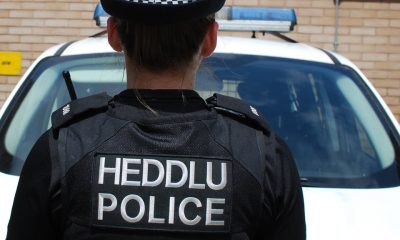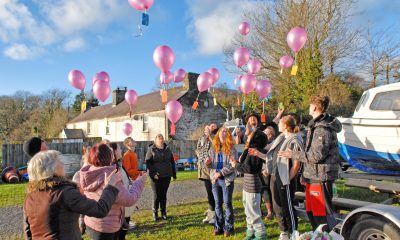News
How Pembrokeshire’s beaches were used as practice for the world’s biggest invasion

By Jon Coles, Andy Chandler and Thomas Sinclair
JUNE 6 marks the anniversary of D-Day, when the Allied forces landed on the beaches of Normandy, France as part of Operation Overlord; a concerted and successful attempt to liberate Europe from the grip of German occupation under Hitler.
The invasion of Normandy (codenamed Operation Neptune) was a massive amphibious assault involving 7,000 ships and 11,000 aircraft. A decoy plan, Operation Fortitude, led the Germans to believe the main target was Pas de Calais. It was a major milestone in securing victory for the allied forces.
Tenby, Saundersfoot, Amroth and Laugharne had already experienced their own version of the Normandy landings – in practice form.
Our local beaches were the location for an extensive two-week-long practice, Operation Jantzen. The exercise commenced on July 22, 1943, and was, thankfully, the only land invasion of Wales during World War II.
Under the watchful eyes of Winston Churchill and Lord Mountbatten (rumour has it that Eisenhower also attended), 100,000 American, Australian, British and Canadian forces had a rare opportunity to practice every element needed for a successful attack on “Fortress Europe”, this involved the initial landings, the setting up of Headquarters and even the moving and stockpiling of vital supplies that would be needed by troops on the front line.
Newsreel footage clearly shows trucks somehow being driven onto flat-bottomed transports in preparation for the training excercise on Tenby Beach, a beach more commonly associated with bathing, swimming and making sandcastles.

THE TROOPS
The Regimental War Chronicles of the Oxfordshire & Buckinghamshire Light Infantry Vol3 1942-1944 records that the First Bucks Battalion had been training in Ayrshire before moving to West Wales.
The road convoy of over 200 vehicles left Ayr on the July 8, 1943, and the main body departed by train three days later. Troops disembarked at Haverfordwest station, where three-ton lorries lifted them to Picton Park.
Picton Park, consisting of Nissen huts and tents, provided an excellent concentration area and preparations for Exercise “Jantzen,” due to start on the July 17, were pressed forward.
All was ready, but the exercise was postponed owing to bad weather, and the move to the assembly area at Cresselly did not begin until July 20.
The area allotted to No. 6 Beach Group consisted of the village of Saundersfoot and its immediate hinterland. There were two small beaches and a tiny port, and the country behind the beaches was hilly and heavily wooded, with narrow country lanes.
No. 5 Beach Group had an equally difficult area some miles to the east with a steep, shingle bank at the head of the beach which made exits and entrances serious problems.
The first key plan prepared before the exercise needed little adjustment and the deployment of thousands of men and hundreds of vehicles and guns proceeded most smoothly.
Coasters and barges were loaded at Tenby and beached at Saundersfoot on a falling tide.
Stores were unloaded first to barge and then to lorry, and, when the coasters had dried out, direct to lorry. Folding boats were not used and the DUKW had still not made its appearance.
On August 5 (D+14) the exercise was closed.
A great many lessons had been learned from “Jantzen.” The organisation and training of the group were sound. The complicated deployment drill had worked smoothly although it had been shown how vulnerable any beach organisation is to deterioration in the weather.
The effort was not only limited to troop movements.
The first major supply exercise involving barges (36 in 3 flotillas), 36 coasters and other forces, took place at Tenby, South Wales in July/August 1943 in Exercise “Jantzen”.
As part of the preparation for sailing across the English Channel for the Normandy landings, “dumb” Thames River barges sailed from the south coast of England around Land’s End and across the Bristol Channel under their own power.
The barges acted as kitchen vessels and troop transports during the exercise.
They subsequently made even longer coastal voyages over to Normandy as supply vessels.

All of which begs the question: Why West Wales?
The beaches of west Wales were chosen because they mimicked the conditions of Normandy being a mixture of salt flats, shingle and wide sandy areas overlooked by dunes. In addition, earlier in the war some of them had been extensively fortified and defensive measures put in place as part of the preparations for invasion.
The importance of experiencing the ‘draft’ of landing beaches was vitally important as were the changing tidal conditions around the West Wales coast.
The area’s roads were also used to give troops experience of moving along thin, rural roads with heavy armour like Tanks and Armoured Troop Carriers.
Speaking to the BBC in 2007, Bentley Howell, whose family lived at Wiseman’s Bridge Inn at the time, remembered some of the events surrounding Operation: Jantzen.
“My half-brother, who was about 40 years old, was at the time the licensee of the Wiseman’s Bridge Inn, Permbrokeshire. In his old age, he used to tell me of his wartime memories and particularly about the day that Winston Churchill called in for a pot of tea.
“A full scale invasion landing practice took place, involving up to 100,000 men, DUKW’s, other landing craft, and troopships disgorging their loads onto the sands of the Saundersfoot bay.
“The publican, John Henry Mathias, or ‘Jack the Bridge’ as he was affectionately known, was appointed a Coastguard because of his local knowledge, and although the whole area had been sealed off for security reasons and a 10pm curfew imposed, Jack was exempt from this and wandered at will.
“Officially, the troops were not allowed to drink, but for 1s 6d they had all they could eat – home killed ham, eggs, fried bread and apple tart. Jack entertained them with tales of a ghostly monk who roamed the tunnels between Saundersfoot and Wiseman’s Bridge.
“One day, several large staff cars swept down the narrow lane to the pub. It was about 3pm, but in those days the pub was open all hours. A blonde woman in an ATS uniform carried out ‘a plain Welsh tea’ to the party of about 15 high ranking officers – later it was learned that she was Sarah Churchill; Winston Churchill surveyed the troops on the beaches together with Admiral Viscount Mountbatten. It was rumoured that Eisenhower was also present”.
For several years after the War, the letter signed by Churchill, thanking the licensee for his hospitality hung on the wall in the pub premises.
In fact, the rumours about Eisenhower’s presence in Pembrokeshire were true, but not quite in the way supposed.
The late and much-missed Vernon Scott wrote in his book An Experience Shared: “Had residents been told on the first day of the fourth month of 1944 that the Supreme Allied Commander, General Dwight D Eisenhower, was in Pembroke Dock, they would have surely dismissed it as an April Fool leg pull. But America’s top soldier in the European Theatre of Operations, really was in the area.”
Eisenhower came to west Wales to inspect the men of the 110th Infantry Regiment, at that time based at Llanion Barracks in Pembroke Dock.
By April 1944, the Regiment was going through last-minute training for the Normandy landings and push for victory.
The Supreme Commander Allied Forces’ visit came as a surprise to the GIs stationed in the County. ‘Ike’ arrived in secrecy at Tenby and was whisked to Pembroke Dock in a staff car kitted out with miniature stars and stripes for the occasion.
The GIs called Pembroke Dock ‘Blitz Ville’, surprised at the extent of the bomb damage in such a small town on the far fringes of Wales.
Pembrokeshire wears its battle-scars proudly, from the huge castles built hundreds of years ago to suppress the native Welsh, to the fuel depots, RAF airfields and anti-aircraft gun bases that were literally thrown up around the county to help protect Great Britain from the power of the Nazi war machine.
The south of the county bore the brunt of Hitler’s wrath. On August 19, 1940, a fuel depot at Llanreath, Pembroke Dock, was bombed by the Luftwaffe. The resulting fire spewed thick, black, oily smoke into the blue skies of Pembrokeshire for 18 days.
The dense plume of smoke could be seen from as far away as the North Devon coast and the fire claimed the lives of 5 Cardiff-based firemen who had been sent down to help deal with the raging inferno as an estimated 100,000 gallons of oil burned.
600 German prisoners of war were also imprisoned in Pembrokeshire during the conflict, with many being placed at local farms to plough, plant and help the Allied war effort ‘dig for victory’.
Looking around today, it’s hard to imagine the full military might of the Allies being put through their paces on our beaches, but our county’s role as a staging area for the biggest naval landing in human history cannot be underestimated
Crime
Emergency bags rolled out to support domestic abuse victims across Dyfed-Powys

Thirty packs provide immediate help for families fleeing dangerous situations
A NEW initiative aimed at supporting victims of domestic abuse has seen thirty emergency bags distributed for use across the Dyfed-Powys Police area.
The bags, which contain essential items including toiletries, non-perishable snacks and emergency supplies, are designed to offer immediate practical support to individuals and families forced to flee abusive situations, often with little or nothing.
The scheme forms part of the Police and Crime Commissioner’s wider commitment to improving outcomes for victims and is being delivered in partnership with Dyfed-Powys Police and Dal i Godi, the commissioned Independent Domestic Violence Adviser (IDVA) service.
Dal i Godi provides specialist support to victims at high risk of serious harm, including safety planning and advocacy through the criminal justice process.
Police and Crime Commissioner Dafydd Llywelyn said the initiative was already proving its value.
“This is an incredible initiative that I’m proud to support,” he said. “It provides meaningful help to those experiencing trauma and reflects our ongoing work to put victims first.
“Within just a few days of the bags being distributed to the Dal i Godi service, one was given to a victim fleeing a domestic abuse situation, along with a children’s pack to support their young family. That shows just how essential this support can be and how quickly it can make a difference.”
Detective Chief Inspector Llyr Williams, from the Dyfed-Powys Police Vulnerability Hub, said the emergency bags could provide a vital lifeline at critical moments.
“These emergency bags offer support at some of the most difficult moments in a person’s life,” he said.
“The contents provide immediate comfort, dignity and practical help for those leaving their homes in crisis. While simple, they represent an important first step towards safety and recovery.
“We are proud to be working with partners across the Dyfed-Powys area to ensure this support reaches people when they need it most.”
Anyone experiencing domestic abuse, or concerned about someone else, is encouraged to seek help. In an emergency, call 999.
Domestic abuse can also be reported online via Dyfed-Powys Police.
Support services available include Victim Support Dyfed-Powys, which offers free and confidential help to anyone affected by crime, whether or not it has been reported, and Dal i Godi, which provides specialist IDVA support for high-risk victims.
The Live Fear Free Helpline offers 24-hour support for those experiencing domestic abuse or sexual violence across Wales.
If you or someone you know is a victim of domestic abuse, please consider reporting it. If you are in danger or need support right away, please call 999.
You can report domestic abuse through the online crime reporting service here: Report domestic abuse | Dyfed-Powys Police.
Support is also available via the below support services:
Victim Support Dyfed-Powys
Free, independent support for anyone affected by crime in the Dyfed-Powys area, whether or not it has been reported to the police.
0300 123 2996
Dal i Godi (IDVA Service)
Specialist support for victims of domestic abuse at high risk, offering safety planning, emotional support, and advocacy with agencies such as police and courts.
01267 221194
Live Fear Free Helpline
24/7 support for anyone experiencing domestic abuse or sexual violence.
0808 80 10 800 | Text 07860 077333
News
Welsh-language school praised for ‘happy, proud and friendly community’

Estyn highlights strong leadership, positive attitudes and a clear curriculum vision at Ysgol Bro Preseli
A WELSH-medium all-age school in Crymych has been praised by inspectors for fostering a “happy, proud and friendly community,” according to a recent Estyn report.
Inspectors said pupils at Ysgol Bro Preseli show pride in their local area, thrive both academically and socially, and are well prepared for the next stages of their learning.
The school currently has 932 pupils on roll, including 118 in the sixth form, and has operated as an all-age school since 2022.
Estyn found that most pupils demonstrate extremely positive attitudes to learning, treat staff with respect, and listen carefully to the contributions of their peers.
The report also notes that, in almost all cases, teachers show strong subject knowledge. Inspectors highlighted the close and supportive relationships staff build with pupils, alongside the creation of a safe learning environment where pupils are not afraid to make mistakes.
It states: “As a result of a clear strategic direction and detailed planning, teachers provide beneficial practical activities that allow pupils to develop purposeful oracy, reading and writing skills in language sessions and across the other areas of learning and experience.”
Inspectors also praised the school’s clear curriculum vision, rooted in its motto Gwreiddiau a Gorwelion (Roots and Horizons).
“Leaders and teachers provide a coherent curriculum and learning experiences that bridge the primary and secondary sectors effectively,” the report said. “Staff plan stimulating activities and experiences for pupils to learn and deepen their understanding within the areas of learning and experience. This contributes positively to the sense of belonging that permeates the whole curriculum of Ysgol Bro Preseli.”
Headteacher Rhonwen Morris said the report was a reflection of the collective effort across the school community.
“As a successful all-age Welsh-medium school, we are delighted that the report recognises our commitment to excellence and the unique identity that makes Ysgol Bro Preseli so special,” she said.
“Since becoming an all-age school in 2022, our cohesive leadership team and governing body have focused on building a strong foundation based on our values of Welsh ethos, kindness, community and responsibility.
“The report highlights the excellent strategic work of staff at all levels, which is a testament to the shared dedication and vision that drives our school forward.
“It is gratifying that the report reflects what we continuously aim to achieve day in and day out. This achievement belongs to our entire community — staff, pupils, parents and governors — and together we will continue to build on this success and provide the very best education for every pupil.”
Charity
Welsh opticians raise £1,600 for people experiencing homelessness

SPECSAVERS Pembroke Dock has helped raise £1,600 to support people experiencing homelessness this winter, with all funds going to The Wallich’s winter appeal.
Thirteen stores from North, South and West Wales donated £1 for every customer feedback form completed during November to help The Wallich, Wales’ largest homelessness and rough sleeping charity, continue its vital work.
Supporting more than 8,000 people experiencing or at risk of homelessness across the nation each year, The Wallich runs around 100 diverse projects across 20 local authorities to provide hope, support and solutions to end homelessness.
Funds raised by Specsavers will go directly to the Wallich’s Flexible Assistance Fund, which provides small but vital emergency grants. The grants support people at crucial turning points, helping cover essential costs such as phone credit, rent or food shops.
This initiative is a continuation of Specsavers’ wider homelessness programme, which sees over a hundred Specsavers stores and Home Visits services hold out-of-hours or pop-up clinics and invite people affected by forms of homelessness to use their services for free.
Specsavers’ North Wales regional relationship manager, Martin Lawrence, who helped organise the fundraiser, says: ‘We’re really proud to be supporting The Wallich’s winter appeal at a time when support is needed most.
‘Homelessness affects people in every community and as locally owned and run businesses, Specsavers stores are committed to raising awareness of the issue and supporting people through their toughest moments.
‘We’re excited to build on the success of this fundraiser and strengthen our partnership with The Wallich in the new year.’
Louisa Turner, head of fundraising at The Wallich, adds: ‘Winter can be an incredibly difficult time for people experiencing homelessness and this support from Specsavers will make a real difference.
‘The funds raised will help provide emergency grants at critical moments – whether that’s putting food on the table, helping someone stay connected with their loved ones or preventing someone from losing a safe place to live.
‘This kind of support creates vital turning points and helps people move towards a safer, more secure future.’
Specsavers works year-round with homelessness charities including Crisis, Vision Care and The Big Issue, to improve access to healthcare and advocate for policy change – ensuring people experiencing homelessness can receive free eye tests, glasses and hearing checks.
To find out more about Specsavers or to book an appointment at your local store, visit: https://www.specsavers.co.uk/stores.
-

 Crime2 days ago
Crime2 days agoMilford Haven man jailed after drunken attack on partner and police officers
-

 News5 days ago
News5 days agoDyfed-Powys Police launch major investigation after triple fatal crash
-

 Crime2 days ago
Crime2 days agoTeenager charged following rape allegation at Saundersfoot nightclub
-

 Crime3 days ago
Crime3 days agoMan charged with months of coercive control and assaults
-

 Crime4 days ago
Crime4 days agoMan sent to Crown Court over historic indecent assault allegations
-

 Crime6 days ago
Crime6 days agoMan spared jail after baseball bat incident in Milford Haven
-

 Crime4 days ago
Crime4 days agoMilford Haven man admits multiple offences after A477 incident
-

 Crime3 days ago
Crime3 days agoWoman ‘terrified in own home’ after ex breaches court order


































